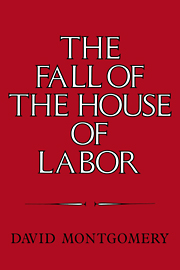Book contents
- Frontmatter
- Contents
- Acknowledgments
- Abbreviations used in text and notes
- Introduction
- 1 The manager's brain under the workman's cap
- 2 The common laborer
- 3 The operative
- 4 The art of cutting metals
- 5 White shirts and superior intelligence
- 6 “Our time … believes in change”
- 7 Patriots or paupers
- 8 “This great struggle for democracy”
- 9 “A maximum of publicity with a minimum of interference”
- Index
9 - “A maximum of publicity with a minimum of interference”
Published online by Cambridge University Press: 11 September 2009
- Frontmatter
- Contents
- Acknowledgments
- Abbreviations used in text and notes
- Introduction
- 1 The manager's brain under the workman's cap
- 2 The common laborer
- 3 The operative
- 4 The art of cutting metals
- 5 White shirts and superior intelligence
- 6 “Our time … believes in change”
- 7 Patriots or paupers
- 8 “This great struggle for democracy”
- 9 “A maximum of publicity with a minimum of interference”
- Index
Summary
From East Pittsburgh to Ludlow, the maturing of modern corporate management had stimulated various forms of employee organization within the workplace. The government's wartime quest for total mobilization of the American people's hearts, minds, and energies had prompted its administrative agencies not only to promote national standards of wages and hours but also to encourage corporate managers to bargain with elected representatives of their employees. In one form or another, the shop committee or works council had appeared in many enterprises by 1920 as the unanticipated companion of the efficiency expert. It was cultivated simultaneously by corporate executives, officials of the federal government, AFL leaders, and socialist militants. Because each of those promoters had quite different purposes in mind, the shop committee emerged at the close of the war as a theater within which struggles for workers' control based on total organization of all workers at the point of production clashed with employers' efforts to exclude unions from their enterprises, and both clashed with the government's search for a mechanism to mediate industrial disputes and improve productivity. The consolidation of scientific management was thus achieved in a manner far different from what Frederick Winslow Taylor had predicted, but one that decisively shaped the contours of American social life during the 1920s and the nature of the industrial unionism that ultimately emerged in the 1930s.
- Type
- Chapter
- Information
- The Fall of the House of LaborThe Workplace, the State, and American Labor Activism, 1865–1925, pp. 411 - 464Publisher: Cambridge University PressPrint publication year: 1987
- 2
- Cited by



